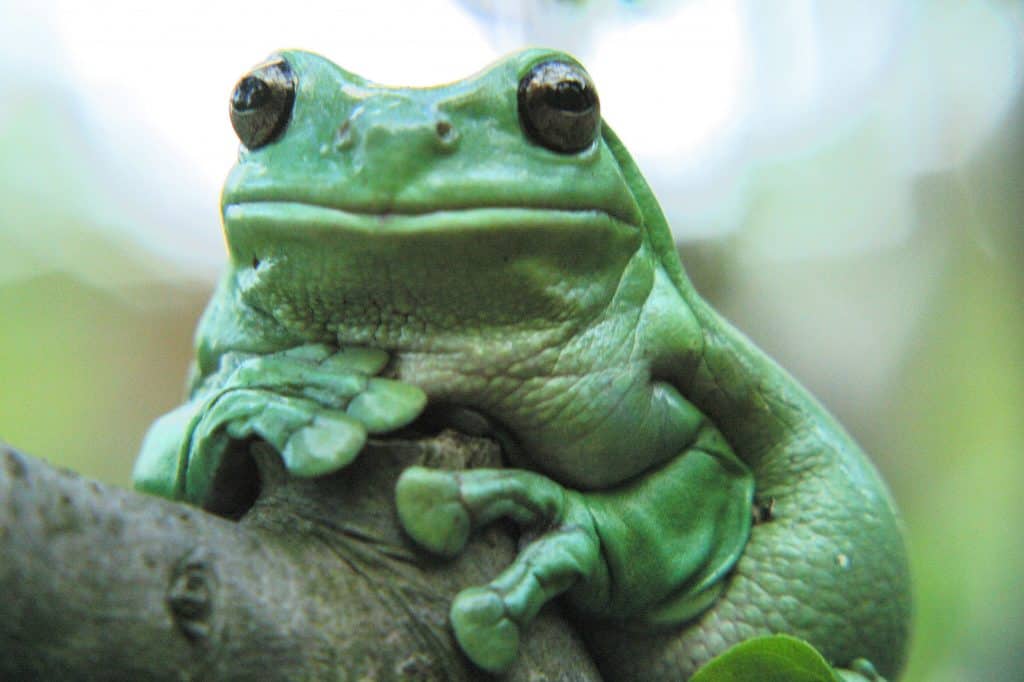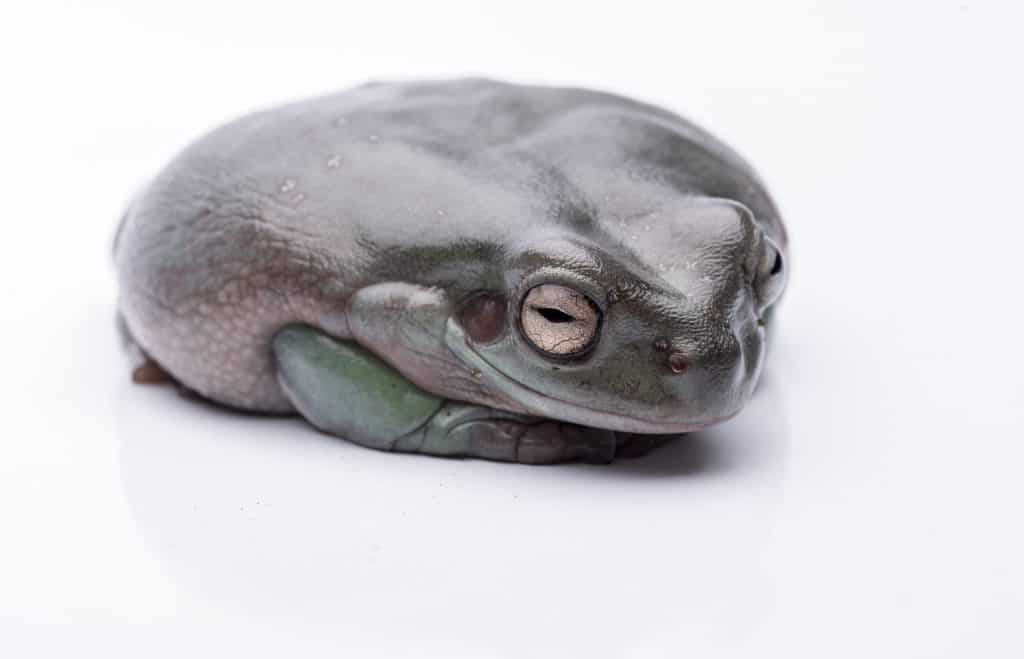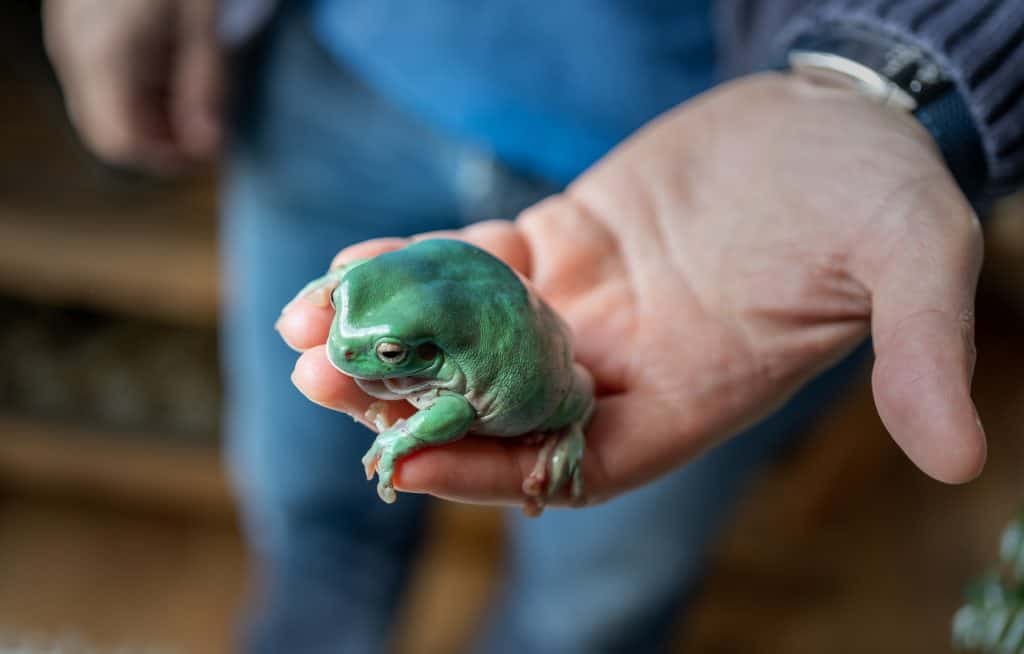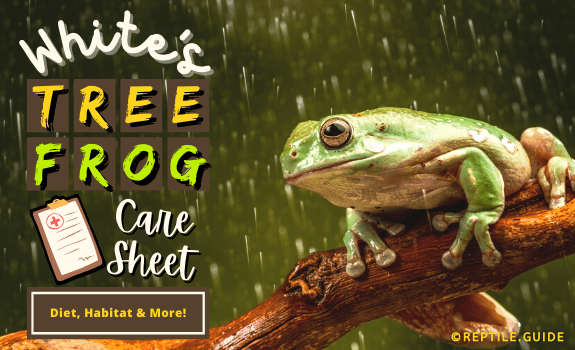The White’s tree frog (Ranoidea caerulea) is a highly charismatic and docile frog with simple care requirements.
These attributes – along with its pleasant green or bluish coloration – make it one of the most popular frog species in the pet trade.
Another reason for the White’s tree frog’s popularity is that – unlike most other amphibians – individuals can become reasonably tame and tolerate gentle handling.
The White’s tree frog is a good beginner species. It’s resistant to desiccation (drying out) and disease. Like any amphibian, these frogs do have specific care needs – including proper housing and a nutritious diet.
This comprehensive guide will explain how to provide the best possible care for White’s tree frogs.
You’ll also learn how to safely handle your frog and all about the species’ ecology and conservation in the wild.
In This Article
What You’ll Learn:
- The ideal diet for White’s tree frogs
- How to build a suitable terrarium setup
- How often to feed your frog at any age
- How to prevent and treat common health issues
- Biology and conservation of White’s tree frogs in the wild
- Perfect environmental conditions, such as temperature, lighting, and humidity
…and much more!
White’s Tree Frog Background Information
Description
White’s tree frogs are big frogs – reaching around 4.5 inches from snout to vent. Females grow larger than males.
Adults have a pudgy stature. They also possess a distinctive fatty ridge above each large, bulbous eye.

Coloration can vary, typically ranging from bronze or brown to vivid emerald green. Some individuals even have a bluish hue or white speckles. Individuals can change color in response to environmental conditions. When stressed, frogs will often appear grey.
Biology
White’s tree frogs (Ranoidea caerulea) belong to the family Pelodryadidae, the Australian tree frogs. They’re also referred to as “Australian green tree frogs” or “dumpy tree frogs” due to their chubby, green appearance.
Fun Fact: The Latin name, “caerulea,” meaning “blue,” is a misnomer. This name arose as a result of a shipment of original specimens being damaged by preservatives. The preservative artificially altered the balance of blue and green pigment, resulting in vivid blue coloration.
In the wild, White’s tree frogs inhabit warm, humid regions. They live in northern and eastern Australia, as well as parts of New Guinea and Indonesia.
White’s tree frogs are arboreal. Their large, sticky toe pads allow them to defy gravity and escape ground-dwelling predators.
Like most tree frogs, they primarily inhabit vegetated areas. Stands of old eucalyptus make ideal habitats for this species due to the tendency of tree crevices to accumulate pools of rainwater.
As amphibians, White’s tree frogs need to keep their skin moist at all times. This trait is one of the critical differences between amphibians and reptiles.
White’s tree frogs have an outer coating of proteins and lipids that reduce water loss. They can be found in habitats far from bodies of water, including urban areas. This species is a common sight in public restrooms and other moist human environments.
Males often enter pipes and culverts to amplify their breeding calls.
As a nocturnal species, White’s tree frogs are more active at night. They spend most of their days tucked away in moist crevices. Being nocturnal allows them to conserve moisture and avoid the sun’s heat.
Another trick to avoid desiccation is their ability to secrete a milky coating that reduces water loss from the skin. During periods of drought, frogs will cocoon themselves in a mixture of mucus and shed skin to help retain as much moisture as possible.
White’s tree frogs use a long, sticky tongue to capture small prey. Unlike e.g. chubby frogs (whose small jaw does not allow them to eat large prey) they can use their large, gaping jaws to capture larger prey and use their forelimbs to aid in swallowing.
The lifespan of a White’s tree frog is longer than most other frogs. Typically, they live to around 16 years, but some have reportedly exceeded 20 years in captivity.
Conservation
According to the IUCN Red List of Endangered Species, the White’s tree frog is a species of “Least Concern.” The species is common throughout its wide range. It also tends to do well in urban and suburban areas due to its desiccation resistance.
The chytrid fungus pandemic is possibly the greatest threat to the White’s tree frog. This major disease outbreak threatens amphibians worldwide.
Current evidence suggests that antimicrobial proteins associated with this species’ skin may help to resist chytrid infection. Individuals of the species have been affected by the fungus, so the species is certainly not immune.
Populations have recently become established in parts of Florida. The impacts of these accidental introductions are not yet known.
Where to Buy a White’s Tree Frog
It’s crucial to be responsible when buying any live animal.
White’s tree frogs are commonly sold in pet stores, at reptile and amphibian shows, and by specialist breeders. They’re typically bred in captivity but may also be wild-caught.
Avoid buying wild-caught animals wherever possible. Collecting from the wild (usually New Guinea, as collection is strictly prohibited in Australia) harms wild populations. Wild-caught animals are also more likely to harbor diseases.
Any frog below two inches is likely to have been bred in captivity. Wild-caught frogs are usually sold as adults.
Pet stores typically buy their frogs in bulk from breeders, then sell them alongside a range of other animals. Pet stores often fail to provide appropriate care requirements for amphibians. Improper care advice results in frogs dying quickly due to disease or malnourishment.
Though they can stock healthy frogs, pet stores often stock large numbers together. This practice provides additional opportunities for disease spread.
Buying directly from a reputable breeder is always the best option. Breeders should be well equipped to offer proper care advice. They’re also usually willing to answer any questions you may have down the line.
Reptile shows or expos can be a great place to meet specialist breeders in your area. They also provide an opportunity to find rare and unusual morphs.
When buying a frog, look for signs of good health such as bright eyes and moist skin. Do not buy frogs housed in crowded or dirty conditions or frogs exhibiting signs of disease.
White’s Tree Frog Diet and Feeding Guidelines
White’s tree frogs are primarily insectivorous. In the wild, they feed on insects, arachnids, and other invertebrates.
Occasionally, they will prey on snakes and rodents.
Gut-loaded or dusted feeder insects should make up most of a White’s tree frog’s diet. It’s vital to ensure that nutrient levels are well balanced by offering occasional treats and regular supplements.

Feeder Insects
Live, gut-loaded crickets are likely the best food source for White’s tree frogs. Crickets come in a range of sizes and thus are suitable for froglets as well as adults.
You may occasionally feed your frogs other insects such as moths, grasshoppers, and cockroaches. If you choose to offer wild-caught insects, only take them from pesticide-free sources.
Offer earthworms or pinky mice as occasional treats. These foods are high in fat and should never make up too much of your frog’s diet. The same applies to mealworms, waxworms, and other larvae.
Expert tip: Never feed your frog nightcrawlers raised as fishing bait. These worms can be artificially colored or scented with chemicals that are harmful to amphibians.
Supplements
It’s vital to provide supplements to frogs in captivity.
Ideally, feed crickets a formulated nutritional diet for around 48 hours before feeding them to your frogs. This practice is known as gut loading. A range of commercial cricket feeds are available for this purpose.
Dust crickets with calcium carbonate powder before feeding them to your frogs.
Use a multivitamin mix to dust crickets at least once per week. Ensure that multivitamins contain vitamin A and not beta carotene. Frogs are unable to convert beta carotene into vitamin A.
Expert Tip: It’s important to prevent Vitamin A deficiency in tree frogs, as it can affect their ability to feed. This condition is known as “short-tongue syndrome.”
Water
Frogs obtain water through their skin rather than by drinking orally. Still, water must be available at all times.
Place a large, shallow water bowl in your frog’s terrarium, and top it up regularly. The water must be shallow enough for your frog(s) to rest comfortably inside the bowl. Choose a bowl that’s easy to clean to avoid the build-up of disease-causing bacteria.
Expert tip: Always use amphibian-safe cleaning products for water bowls and other accessories.
Adding rocks to water bowls makes it easier for frogs and feeder insects to exit safely. If feeder insects drown in your frogs’ water, be sure to replace it with fresh water.
Frogs are especially sensitive to chemicals such as chlorine. It’s vital to use chlorine and chloramine-free water sources. The best way to do this is to use either bottled spring water or charcoal-filtered tap water.
If cleaner sources aren’t available, aerating the tap water will remove chlorine. Leave a container of tap water open to the air for at least 48 hours to remove any chlorine before giving tap water to your frog.
How Often to Feed a White’s Tree Frog (at Any Age)
Most keepers feed adult frogs two or three times a week. Adult frogs will typically eat around three large crickets per feed.
Once per month, feed your adult frog a treat such as an earthworm or fuzzy mouse in place of crickets.
Sub adults (1.5 to 3 inches) need to eat around three times per week. They’ll usually eat one or two medium-sized crickets per feed.
Limit treats, such as earthworms, to around once per month for sub-adult frogs.
Feed froglets under 1.5 inches every day or two. They’ll typically eat up to four pinhead crickets per day.
Odd note: Like all animals, the White’s Tree Frog poops. Actually, frogs even produce oddly large poops. Learn what you never knew you needed to know!
White’s Tree Frog Habitat and Tank Setup
White’s tree frogs, like any frog, require a specific housing setup. In this section, we’ll discuss the ideal setup for this species.
The most crucial aspects to your enclosure build are:
- Heat – As tropical species, White’s tree frogs require a constant (safe) heating system.
- Humidity – Amphibians lose water and desiccate easily. Always monitor humidity and ensure that it stays within a safe range.
- Substrate – Substrate serves to absorb dirt and waste, making a terrarium easier to clean. Some substrates are dangerous to your frog’s health.
- Escape-proofing – Tree frogs are natural escape artists. It’s important to prevent frogs from escaping, as they will quickly desiccate once outside of their terrarium.
Each of these elements is equally important to ensure the health of your frog.
Enclosure Size and Shape
Enclosures must be large enough to allow your frogs to move freely and climb. Enclosure shape is an important consideration for these frogs, as enclosures must accommodate tall branches or live plants.
As a good rule of thumb, your tree frog terrarium should be taller than it is wide.
As a minimum, most sources recommend a 20-gallon terrarium to house between one and four frogs. This should be a vertical shape that facilitates climbing. Hexagonal enclosures are perfect, offering plenty of climbing space.
Type of Enclosures
Glass terrariums are ideal for tree frogs, as they allow heat to escape while maintaining humidity. This makes it much easier to maintain healthy environmental conditions for your frog.
Wooden reptile terrariums allow less heat to escape, making it easy for your frogs to overheat.
Any choice of terrarium MUST include a tight-fitting lid to prevent frogs from escaping. This lid must also provide adequate ventilation to avoid respiratory issues.
Ideal Temperature Gradient
White’s tree frogs thrive at temperatures around 24-26 °C (75-80 °F). For most people, this is slightly above average room temperature.
Avoid using heat lamps – unless they are amphibian-specific – to raise the temperature of your terrarium.
A better choice is a heat mat attached to the exterior terrarium wall.
Attaching a heat mat to one terrarium wall creates a slight temperature gradient within your enclosure. The temperature gradient allows frogs to thermoregulate by moving to warmer or cooler parts of their environment.
Ideal Humidity Levels
Like all frogs, White’s tree frogs require high humidity levels to reduce water loss.
This species is more tolerant of low humidity than many others, which is why they’re recommended as great beginner frogs.
Around 50% humidity is ideal for White’s tree frogs.
Mist your terrarium daily with distilled or spring water. You can complete this task manually or using an automated misting system.
If moisture levels in your terrarium are too high, frogs will likely turn dark brown in color. This color change is usually a sign of wet substrate.
Substrate can remain slightly damp to the touch, but not wet. Wet substrate leads to the growth of disease-causing bacteria and fungi.
Substrate
The most important substrate considerations are:
- Moisture retention – This helps you to maintain constant humidity levels within your terrarium.
- Particle size – Small particles are less likely to cause health issues if ingested accidentally.
Substrates that offer “the best of both worlds” include fine particulate soil or ground coconut fiber. Both of these products are sold in most reptile stores.
A few foam-based amphibian terrarium liners are also available as an easy-to-clean alternative.
Many keepers choose to add a drainage layer to their terrarium substrate for optimum drainage and humidity control. Washed gravel beneath your fine particulate substrate makes for a suitable drainage layer. Ensure that gravel is never exposed for your frog to ingest.
Covering exposed soil with moss helps to lockin moisture. Sphagnum mosses are easily ingested, so sheet mosses may be preferable. This material provides a natural look that is visually pleasing and closely mimics the substrate found in the White’s tree frog’s native habitat.
White’s tree frogs are large and messy. Be prepared to spot clean your substrate regularly.
If you want even more specific details, check our White’s Tree Frog Habitat guide.
Lighting
As a nocturnal species, White’s tree frogs do not require any specific lighting. Unlike reptiles, they do not have a specific UVB requirement.
If using UV lighting for live terrarium plants, maintain 12-hour light-dark cycles. This schedule gives your frogs plenty of time for nocturnal activities.
Fluorescent aquarium lights are a good choice to brighten your amphibian enclosures, but many other amphibian-safe lighting options are available.
Decor and Accessories
Branches and other climbable structures are essential for a White’s tree frog terrarium. Ensure that any plants or decor are terrarium-safe before using.
Good options for this large species include
- Sturdy artificial plants
- Sturdy, large-leafed live plants
- Ghostwood and other terrarium-safe branches
For more information, check out our list of ideal vivarium plants.
Keeping Frogs in Groups
Tree frogs are social animals and benefit from living in groups of the same species. Three or four adult frogs can comfortably coexist in the same terrarium.
Ensure that your frogs have enough space to prevent stress and disease.
It’s also vital to ensure that all frogs are of similar size. Large frogs have been known to cannibalize sub-adults.
If you still don’t have enough, check our article on the perfect White’s Tree Frog Habitat.
White’s Tree Frog General Health Information
Intestinal Impaction
Symptoms: Distended stomach, gagging behavior, lack of defecation.
Causes: Usually due to ingestion of large substrate particles.
Prevention: Avoid using large particulate substrate such as gravel, bark, or sphagnum moss.
Treatment: Seek specialist veterinary help.
Bacterial Infection
Symptoms: Cloudy eyes, lethargy, edema (fluid buildup), skin lesions or hemorrhaging.
Causes: Dirty or waterlogged substrate.
Prevention: Regular spot cleaning. Avoiding excessive humidity levels.
Treatment: Sometimes treatable with antibiotics. Quarantine affected frog in a separate terrarium and seek specialist veterinary help.
Obesity
Symptoms: Your frog is overweight.
Causes: Overfeeding or an excess of lipids in the diet.
Prevention/Treatment: Reduce feeder insect quantity gradually. Reduce quantities of lipid-rich “treat” species, such as pinky mice or beetle larvae.
Short Tongue Syndrome
Symptoms: Difficulty capturing prey using tongue. Weight loss and lethargy as a result.
Causes: Vitamin A deficiency.
Prevention/Treatment: Regular diet supplementation with multivitamins including Vitamin A.
Chytrid Fungus
Symptoms: Lethargy, (new) patches of skin discoloration, appetite loss.
Causes: Fungal infection (Bacteriochytridium dendrobatidis).
Prevention: Quarantine new frogs separately for up to a month before adding them to your terrarium.
Treatment: Seek specialist veterinary assistance.
White’s Tree Frog Handling Tips

White’s tree frogs are far more suited to occasional handling than other amphibians. They’re also unlikely to bite or even hop away.
After a period of gentle socialization, these frogs can grow accustomed to humans. At this point, they will comfortably sit in your hands.
As amphibians, White’s tree frogs have skin that is highly permeable. They’re easily damaged by human-made chemicals. These substances include (but are not limited to):
- Soaps
- Lotions
- Perfumes
- Sunscreen
- Detergents
- Mosquito repellents
Be sure to rinse your hands before handling to remove any potentially toxic chemicals. Always thoroughly clean your hands after touching any amphibian.
If you do choose to handle your frog, keep it to a minimum. Too much handling may be fun for you but stressful for your frog!
Is a White’s Tree Frog Right for YOU?
White’s tree frogs are a large commitment to take on.
Make sure you are prepared to care for your animals for their entire lifespan before bringing them home. Remember that these frogs can live over 15 years (so you may want to choose a good name for it)!
If you’d like to know why the White’s tree frog is not a toad, read on!
